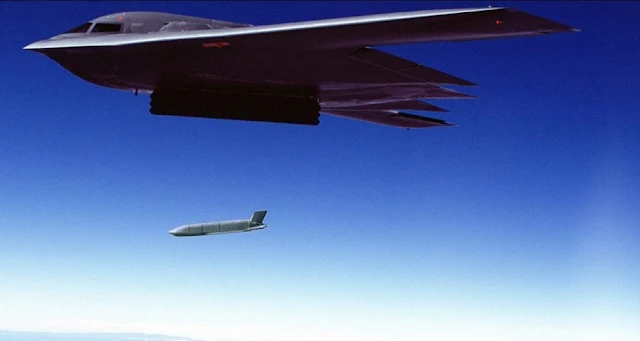 |
| Advanced Cruise Missiles on US B-2 Stealth Bomber Become a Specter for Chinese Warships |
International Military - The United States B-2 stealth bomber has been armed with the advanced AGM-158B JASSM-ER cruise missile. Beijing military experts warned that this weapon would make the B-2 bomber a terrible scourge for Chinese warships if conflict broke out. American defense contractor Northrop Grumman released a statement on August 25 that a B-2 bomber successfully test-fired the AGM-158B Joint Air-to-Surface Standoff Missile-Extended Range (JASSM-ER) in December 2021.
The JASSM-ER is a long-range variant of the basic AGM-158 JASSM, which has a range of 370 kilometers. “JASSM-ER further enhances the B-2's ability to hit any target, anywhere. The JASSM-ER integration enables the delivery of low-observable assets capable of traveling greater distances than their predecessors," Northrop said in a statement.
Fu Qianshao, a Chinese military expert who is a retired People's Liberation Army (PLA) Air Force equipment specialist, said the JASSM-ER has a range of about 1,000 kilometers and can threaten PLA Navy warships. "The PLA needs to push forward into the western Pacific Ocean to warn [American] aircraft," Fu told the South China Morning Post (SCMP).
 |
| advanced cruise missile AGM-158B JASSM-ER Used on the US B-2 stealth bomber |
The US Air Force (USAF) has increasingly deployed B-2 bombers in the Indo-Pacific region in recent years. In 2020, three B-2 bombers arrived on the Indian Ocean island of Diego Garcia to support US security commitments in the Indo-Pacific region. Also, this year in March, the USAF B-2 Spirit undertook a mission in the Indo-Pacific with five different fighters, including two F-35As, two EA-18 Growlers, and two F/A-18F Super Hornets, two F-16C, and a KC-135 tanker.
That was followed by the deployment of four B-2 bombers in July at Royal Australian Air Force (RAAF) Base Amberley in Queensland in support of the Air Force Pacific Bomber Task Force. This is the first time the B-2 has been deployed to Australia as part of the Bomber Task Force (BTF).
The deployment lasted until the end of August, during which the B-2s took part in various joint exercises with the Australian Defense Force as part of the Enhanced Air Cooperation Initiative under the Posture of Forces Agreement between the US and Australia.
The B-2 bomber is one of the three legs of the US nuclear triad. Due to their stealth features, such as radar-absorbing materials and engines hidden in the body, these aircraft can approach the enemy unnoticed and launch missiles or drop bombs.
However, the stealth design does not make the B-2 invincible, as China continues to develop its air defenses, especially with a focus on counter-stealth technology. Therefore, adding long-range cruise missiles such as the JASSM-ER could allow the B-2 to strike targets from distances where air defenses cannot detect or intercept the bomber, making it even more lethal.
In addition, the JASSM-ER also has a stealth design which means the missile will be difficult to intercept by enemy air defenses. Last year, while serving as commander of USAF's Global Strike Command, General Timothy Ray told the US Senate that the AGM-158B missile was critical to ensuring that nuclear bombers could go to war. However, Fu told SCMP that the subsonic AGM-158B missile travels slower than sound and, therefore, is more easily intercepted by China.
The Beijing-based commentator also said the US would only deploy the B-2s in the event of a confrontation with China. Abhijit Iyer Mitra, a senior fellow at the Institute for Peace and Conflict Studies told the EurAsian Times that as a stealth missile, the JASSM-ER although relatively slower will remain hidden from enemy radar along its flight path.
He further said that even when the missile appears above the radar, due to its small size, it will remain a small target, leaving very little reaction time as the radar will not be able to detect it until the missile is only 2-3 kilometers from its target. So, the main challenge of enemy air defense is to detect missiles, without intercepting them is impossible.
